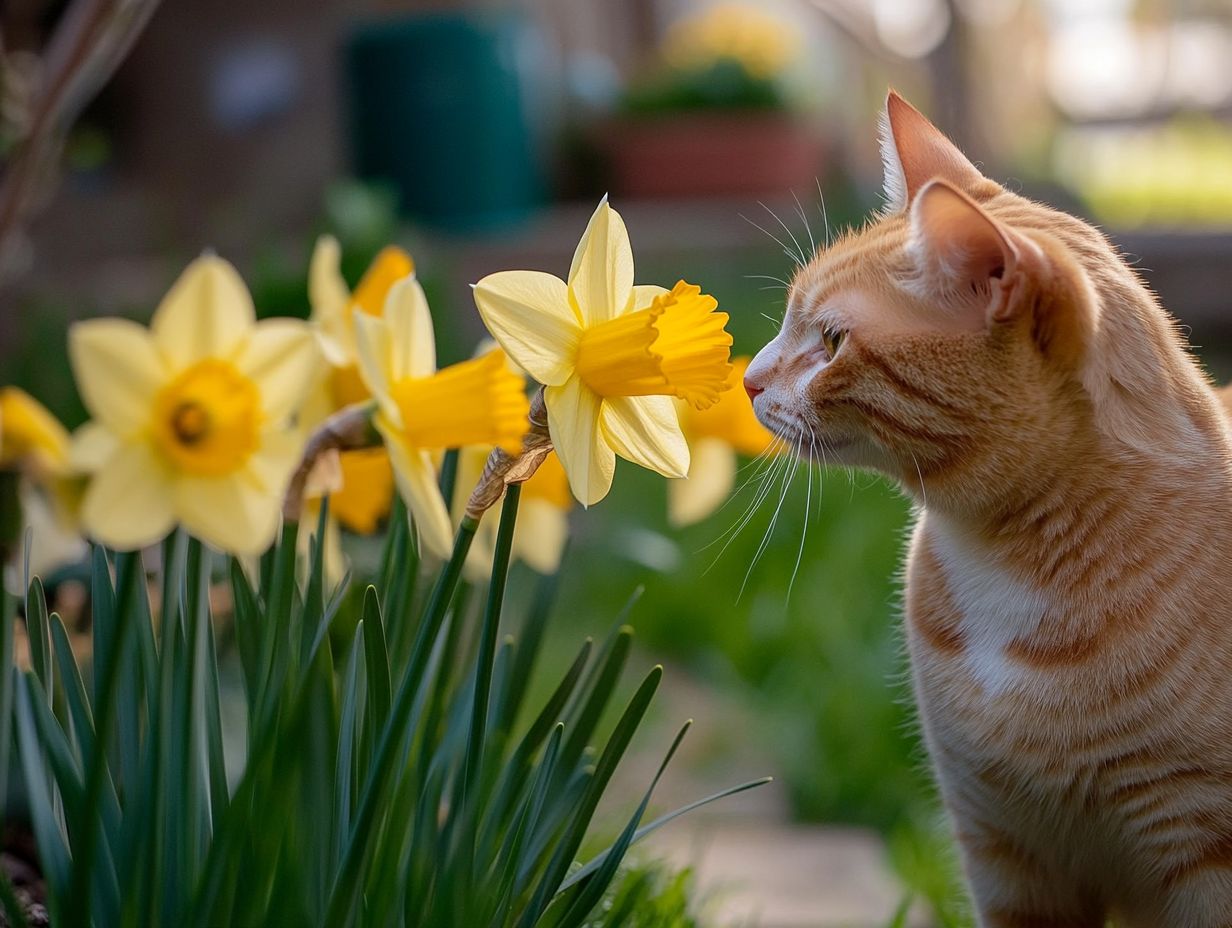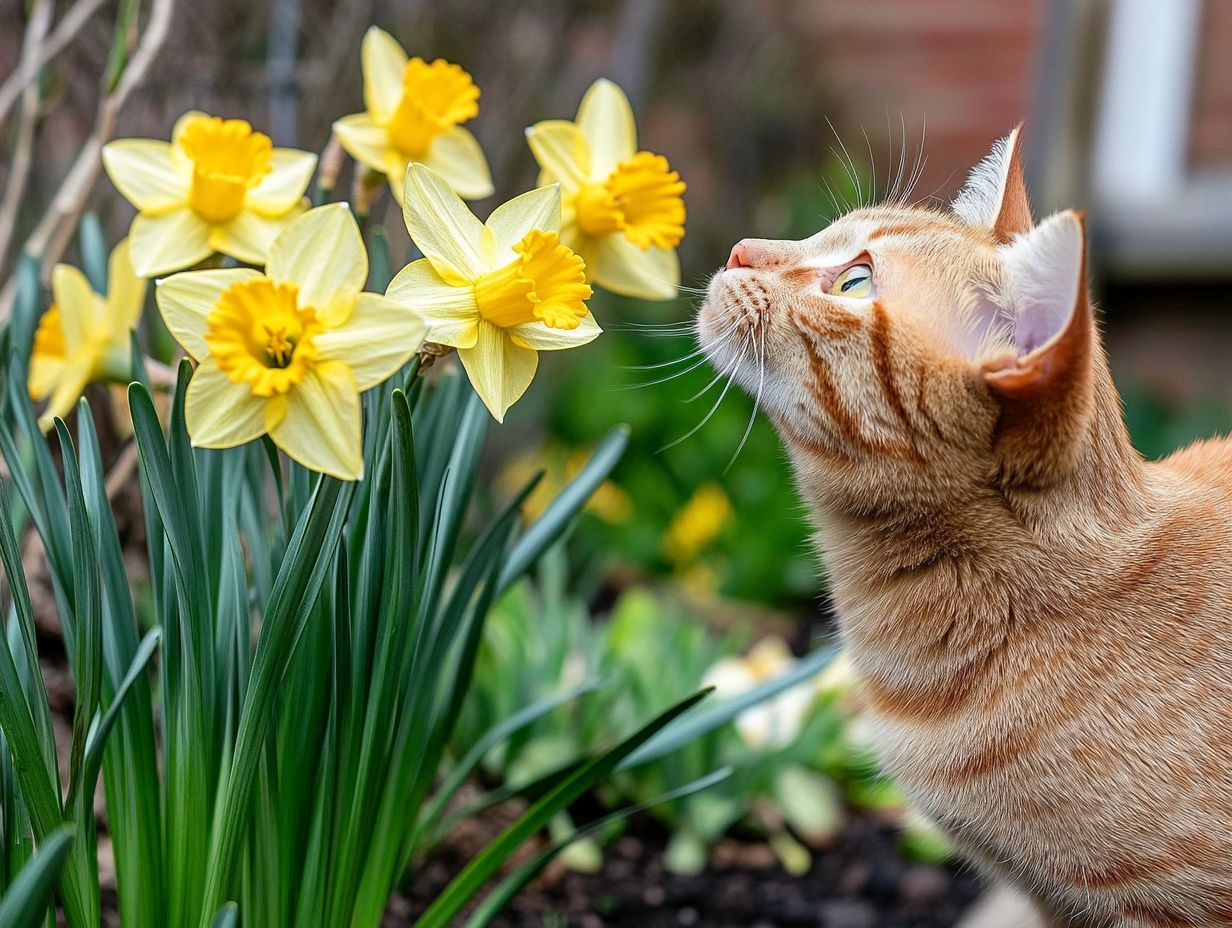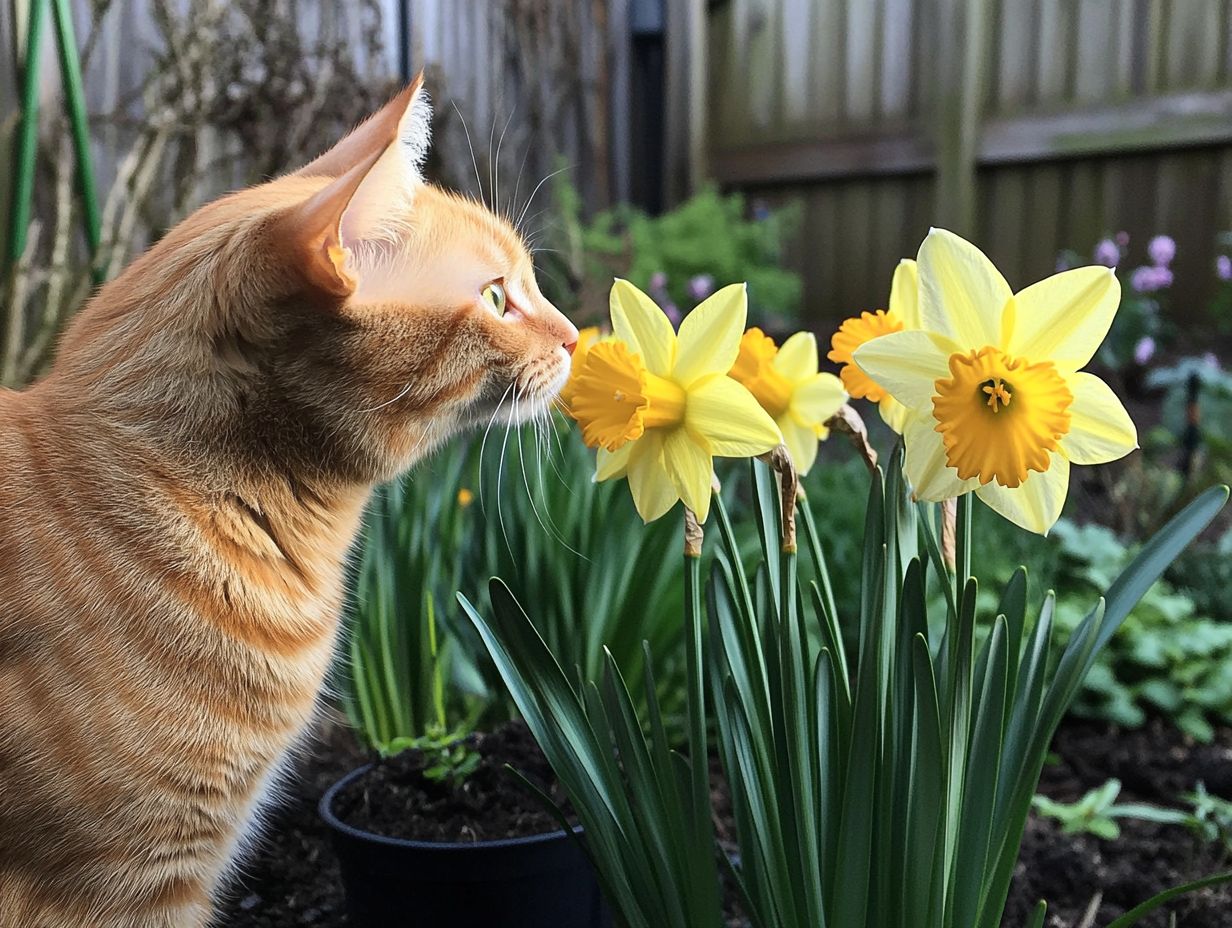Daffodils are a beloved spring flower, known for their bright yellow blooms and uplifting presence in gardens.
For cat owners, these beautiful plants come with a hidden danger. Understanding the risks daffodils pose to felines is crucial, especially since certain parts of the plant, like alkaloids such as lycorine, can be toxic.
This article explores the dangers of daffodils, symptoms of poisoning, and practical tips to keep your cat safe. Discover the best ways to enjoy your garden while ensuring your furry companion remains healthy and happy.
Key Takeaways:

- Daffodils are toxic to cats and can cause serious health issues if ingested.
- Symptoms of daffodil poisoning in cats can include vomiting, diarrhea, and difficulty breathing.
- To keep your cat safe, take precautions when planting daffodils and consider using alternative, non-toxic plants in your garden. Consulting with your veterinarian for plant safety is advisable.
What Are Daffodils?
Daffodils, scientifically known as Narcissus, belong to the Amaryllidaceae family and are among the most popular flowering plants used in gardens. These spring-blooming perennial flowers are celebrated for their bright yellow and white blossoms and are often among the first to bloom in the spring.
While they are visually appealing, daffodils can pose a potential danger to pets, particularly cats. They can also affect dogs and horses, so it is essential for pet owners to be aware of this when spending time in the garden. Understanding the characteristics of daffodils and how to care for them can help create a safe environment for both humans and pets. For more information, check out this article on Are Daffodils a Risk for Cats? Vet-Recommended Safety Tips.
Are Daffodils Toxic to Cats?
Daffodils are classified as toxic to cats. Yes, daffodils are toxic to cats due to the presence of alkaloids, particularly lycorine, which can cause severe health issues if ingested. This toxicity presents a significant risk for pet owners who have daffodils in their gardens.
Symptoms of daffodil poisoning can manifest quickly, making it essential for responsible pet owners to understand these risks. Timely intervention at the first signs of poisoning can greatly improve the prognosis for affected pets.
What Parts of the Daffodil are Toxic to Cats?
Toxic parts:
- Bulbs
- Leaves
- Stems
- Flowers
Daffodil plants are toxic to cats, with the bulbs containing the highest concentration of harmful substances. Toxicity also extends to the leaves, stems, and flowers of the daffodil, potentially causing a range of poisoning symptoms.
Even small amounts ingested by curious cats can lead to serious health complications, making it crucial for pet owners to understand the dangers of these plants in their homes or gardens. The bulb is particularly hazardous due to a compound called lycorine, which can induce vomiting, diarrhea, and abdominal pain in affected cats.
Ingesting any part of this beautiful plant may also result in neurological symptoms, such as lethargy or disorientation. For these reasons, cat owners should keep daffodils out of reach and educate themselves on how to identify potentially toxic plants.
Creating a safe environment by choosing non-toxic plant alternatives can significantly reduce the risk of accidental ingestion.
What Happens if a Cat Ingests Daffodils?
If a cat ingests daffodils, it may exhibit symptoms of poisoning, including nausea, vomiting, and diarrhea. The severity of the reaction can vary depending on the amount consumed and the overall health of the individual cat. Consulting with a vet, such as those at PangoVet, is essential for proper care and recovery.
If a cat ingests daffodils, it may exhibit symptoms of poisoning, including nausea, vomiting, and diarrhea. The severity of the reaction can vary depending on the amount consumed and the overall health of the individual cat.
In some cases, the ingestion of these flowers can lead to more serious symptoms such as abdominal pain and lethargy, which can be concerning for pet owners. Understanding the toxicity of daffodils is crucial, as even a small amount can cause distress. Owners should closely monitor their pets and seek veterinary care immediately if they suspect ingestion.
First Aid and Treatment
In case of suspected ingestion of daffodils, follow these steps:
- Check for any signs of distress or symptoms listed above.
- Remove any remaining plant parts from the cat’s vicinity.
- Contact your veterinarian or an emergency animal clinic immediately.
- If possible, take a sample of the plant to assist in identification.
- Follow any instructions provided by veterinary professionals.
Always prioritize contacting a veterinarian, as prompt medical attention is critical.
Prevention and Safety Measures
To keep your cat safe from daffodils:
- Plant daffodils in areas inaccessible to your pets.
- Educate yourself on other toxic plants and avoid planting them in your garden.
- Consider using non-toxic alternatives, such as marigolds or snapdragons, to enhance your garden.
- Regularly monitor your garden for any signs of invasive toxic plants.
Special Considerations
Be extra cautious with:
- Kittens: They are naturally curious and may ingest more plant material.
- Senior cats: They may have weakened immune systems and be more susceptible to toxins.
- Cats with pre-existing health conditions: These animals may react more severely to toxins.
Address any concerns with your veterinarian about your specific pet’s health.
Common Misconceptions
Many pet owners mistakenly believe that all garden flowers are safe for pets. This belief may stem from a lack of awareness of the potential toxicity of certain plants, including daffodils. It’s vital to research the plants you have in your garden to avoid any harmful situations.
For further reading on toxic plants, check out reputable sources such as veterinary journals or toxicology databases.
In case of an emergency, contact the ASPCA Animal Poison Control Center at (888) 426-4435.
Disclaimer: The information provided here should not replace professional veterinary advice. Always consult a veterinarian for concerns regarding your pet’s health.
This article was last reviewed on [insert date here].
Daffodils are considered toxic to cats. The parts of the plant that are particularly hazardous include the bulbs and leaves, which contain toxic compounds such as lycorine.
Treatment typically involves supportive care, including intravenous fluids, medications to manage symptoms, and monitoring in a clinical setting to ensure the cat’s safety (Source: Veterinary Toxicology Journal). This approach can significantly improve the prognosis for a pet affected by daffodil poisoning.
What Are the Symptoms of Daffodil Poisoning in Cats?

Symptoms of daffodil poisoning in cats include nausea, vomiting, diarrhea, and oral irritation. Pet owners should be vigilant for these signs, as they may indicate the need for immediate intervention to ensure the health and safety of their cats. For more information, check out Are Daffodils a Risk for Cats? Vet-Recommended Safety Tips.
Early recognition of daffodil poisoning symptoms can significantly improve treatment outcomes and shorten recovery times.
How Long Does it Take for Symptoms to Appear?
Symptoms of daffodil poisoning in cats can manifest within a few hours of ingestion, depending on the amount consumed and the individual cat’s sensitivity to the toxic compounds. Factors such as the cat’s size and dietary habits may influence the onset of these symptoms.
Therefore, pet owners should closely monitor their cats after potential exposure to these plants and be prepared to take swift action if symptoms arise. Because the concentration of toxic compounds in daffodils can vary based on the specific type of daffodil and its growing conditions, diligent observation is crucial.
A smaller cat or one with pre-existing health issues may experience more severe reactions than a larger, otherwise healthy animal. Common signs to watch for include vomiting, diarrhea, and lethargy, which can develop rapidly.
Prompt veterinary attention can significantly impact recovery outcomes, underscoring the importance of careful monitoring during the critical hours following an incident.
What Should You Do if Your Cat Ingests Daffodils?
The first step in treating a cat that has ingested daffodils is to assess the severity of the situation by determining how much has been consumed and whether any symptoms are present. If your cat displays signs of distress, such as vomiting, diarrhea, or lethargy, it is crucial to remember that the potential toxicity of daffodils can be life-threatening, and treatment should not be delayed. In severe cases, low blood pressure and neurological symptoms may occur, requiring immediate veterinary intervention.
- Contact your veterinarian or an animal emergency clinic immediately.
- Keep your cat calm and comfortable while awaiting medical assistance.
- Ensure it has access to fresh water.
After evaluating the severity of your cat’s daffodil ingestion, the next step is to contact your veterinarian or an animal emergency clinic like Vets Now in Nottingham immediately to discuss treatment options. Proper hydration and care can significantly impact the prognosis.
How Can You Keep Your Cat Safe from Daffodils?
To keep your cat safe from daffodils, you can take preventive measures to ensure that these harmful plants are not present in your garden or home. Responsible pet ownership involves understanding which plants are dangerous to pets and taking steps to mitigate that risk. Consulting with veterinary professionals like Anna Shaw at Clinical Intelligence can provide valuable insights into pet safety.
Creating a cat-safe garden requires knowledge of safe plants and a commitment to vigilance. Incorporating non-toxic alternatives such as cat grass or herbs can enhance garden safety.
What Precautions Should You Take When Planting Daffodils?
When planting daffodils, it is important to take precautions to protect your cat. This involves selecting locations that are out of reach for pets and informing visitors about the potential dangers.
Understanding the toxicity of each plant and using barriers are additional measures to consider for keeping cats safe. Choosing a location that is inaccessible to your cat not only enhances their safety but also promotes better growth for the flowers.
Knowing whether the daffodil you are planting is toxic, particularly which parts of the plant are hazardous (such as the bulbs and leaves), can help you make informed decisions. Utilizing physical barriers like fences and decorative rocks can deter curious cats from entering the area.
Health Effects of Daffodil Poisoning
- Immediate effects: nausea, vomiting, diarrhea
- Long-term effects: potential kidney damage if untreated
Common Misconceptions
It’s a common misconception that all parts of the daffodil are equally toxic. In reality, the bulbs and leaves are the most toxic parts of the plant.
Specific risks apply to kittens and senior cats, as their reactions might be more severe compared to healthy adult cats.
For any suspected poisoning, contact ASPCA Animal Poison Control at (888) 426-4435. Remember that this information is for educational purposes only and is not a substitute for professional veterinary advice.
Ensure that the content is regularly reviewed and updated; the last review date is [Insert Date].
For more information, explore related topics such as other toxic plants or detailed information on cat safety.
Additionally, monitoring the flowerbeds ensures that no petals or debris that could pose a risk if ingested are blown into unsafe areas. By employing a combination of these strategies, you can protect your cat while enjoying the beauty of daffodils in your garden.
Are There Any Safe Alternatives to Daffodils for Cat-Friendly Gardens?

Yes, there are many safe alternatives to daffodils that can be planted in a cat-friendly garden. Options include catnip, lavender, and various herbs. By choosing non-toxic plants, pet owners can enjoy a beautiful garden without putting their cats at risk.
Here are some alternative plants suitable for a cat-safe garden:
- Marigold – Bright and cheerful, they are easy to grow and non-toxic.
- Sunflower – Known for their height and beauty, sunflowers are safe for cats.
- Catnip – A favorite among felines, provides entertainment and stimulation.
- Lavender – Not only safe but also calming and fragrant.
- Decorative succulents or grasses – Aesthetic options that are also non-toxic.
What Other Plants are Toxic to Cats?
Plus daffodils, several other plants pose serious risks to cats and can lead to poisoning or other health issues if ingested. Common toxic plants for cats include lilies, azaleas, and oleander, among others. Pet owners should be aware of these dangers, as some toxic plants may be present in their households or gardens without their knowledge.
What Are Some Common Symptoms of Plant Poisoning in Cats?
Common symptoms of plant poisoning in cats may include:
- Mild: Vomiting, diarrhea.
- Moderate: Lethargy, oral irritation.
- Severe: Difficulty breathing, irregular heart rates, seizures.
Recognizing these signs is crucial for prompt veterinary intervention, as they can quickly escalate into severe complications or even be fatal if treatment is delayed.
What to Do if Your Cat Ingests a Toxic Plant?
If you suspect your cat has ingested a toxic plant, follow these steps:
- Identify the plant and gather information on its toxicity.
- Contact your veterinarian or a poison control helpline immediately.
- Do not induce vomiting unless directed by a professional.
- Provide any necessary information about your cat’s behavior and symptoms.
Immediate veterinary contact is essential for effective treatment.
Therefore, pet owners should closely observe their cats’ behavior, especially if the animals have access to potentially toxic plants like daffodils. Seeking veterinary intervention as soon as possible not only facilitates the identification of the specific type of plant poison but also allows for prompt treatment, thereby maximizing the chances of recovery. For more information, check out this article on Are Daffodils a Risk for Cats? Vet-Recommended Safety Tips, which discusses the dangers of Narcissus plants.
How Can You Prevent Your Cat from Eating Toxic Plants?
Preventing your cat from eating toxic plants requires a combination of education, environmental management, and the provision of safe alternatives. Pet owners can create a secure environment by removing hazardous plants from their homes and gardens while incorporating non-toxic options that cater to their cat’s natural instincts, reducing the risk of poisoning and ensuring their health.
First and foremost, educating yourself about which plants are toxic is essential. This information is often available through reputable animal welfare organizations or veterinary resources. Additionally, practicing safe gardening techniques, such as using plant barriers or establishing designated cat-free zones, helps maintain a secure environment for your pet.
Offering safe alternatives like cat grass or catnip not only keeps your feline friend entertained but also redirects their attention away from harmful plants. Regularly monitoring your indoor and outdoor spaces can further enhance their safety, ensuring that your beloved pet remains happy and healthy while exploring their surroundings.
Frequently Asked Questions
Are Daffodils a Risk for Cats?

Yes, daffodils can be toxic to cats if ingested. All parts of the plant, including the bulb, flowers, and leaves, contain lycorine, which can cause vomiting, diarrhea, and even more serious symptoms such as difficulty breathing and low blood pressure. Hence, daffodils are classified as toxic.
Why Are Daffodils Toxic to Cats?
Daffodils contain lycorine, a toxic compound that affects cats if ingested. It’s crucial to be aware of this to ensure your cat’s health.
Disclaimer: Always consult your veterinarian for personalized advice and treatment regarding your pet’s health.
Call to Action: For emergencies, contact the ASPCA Animal Poison Control at 1-888-426-4435.
Last Updated: October 2023
Important: Daffodils are toxic to cats. All parts of the plant, especially the bulbs, are toxic due to the presence of the compound lycorine, which can cause a range of symptoms when ingested.
What are the symptoms of daffodil poisoning in cats?
The symptoms of daffodil poisoning in cats can be categorized by severity:
- Mild Symptoms: Vomiting, diarrhea, drooling, abdominal pain, lack of appetite.
- Severe Symptoms: Difficulty breathing, low blood pressure, heart arrhythmias, and severe reactions requiring emergency veterinary care.
What should I do if my cat eats a daffodil?
If you suspect that your cat has ingested a daffodil, it is important to:
- Contact your veterinarian immediately.
- Do not induce vomiting.
- Avoid giving any home remedies.
- Your vet may recommend inducing vomiting or administering activated charcoal to help absorb lycorine toxins.
Note: Immediate veterinary contact is crucial.
Can cats be allergic to daffodils?
Yes, cats can have allergic reactions to daffodils, similar to other plants. Symptoms may include skin irritation, itching, and swelling. If your cat exhibits any of these symptoms after coming into contact with daffodils, it is best to consult with a veterinarian to ensure safety and prevent future exposure.
Are there any safe alternatives for cats to enjoy spring flowers?
Yes, there are several cat-safe plants and flowers that you can have in your home, including:
- Spider plants
- Catnip
- Orchids
Just be sure to research each plant before bringing it into your home to ensure it is safe for your furry friend.
Common Myths about Daffodils and Cat Safety
Many believe that only certain parts of the daffodil are toxic, but this is incorrect. All parts of the daffodil contain lycorine and can pose health risks to cats.
Special Considerations
Kittens and cats with pre-existing health conditions may be at a higher risk for severe reactions, making vigilant monitoring essential.
For more information, contact: ASPCA Animal Poison Control.
Disclaimer: This content is for informational purposes only and does not substitute for professional veterinary advice. Always consult a veterinarian for guidance.
Regular Updates Reminder: Please remember to regularly review and update this content as new research emerges. Last reviewed: [insert date].
For further reading, check our articles on other toxic plants to keep your pets safe.